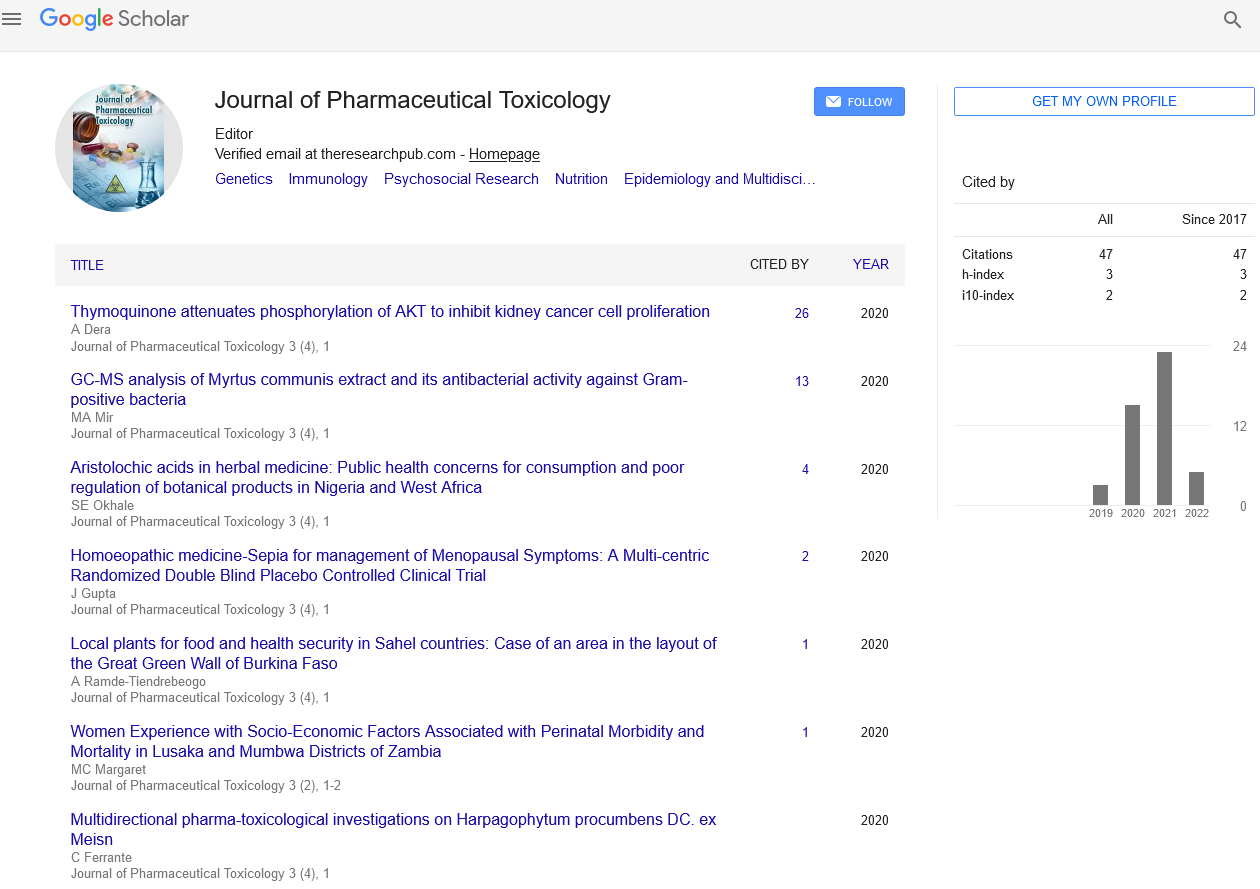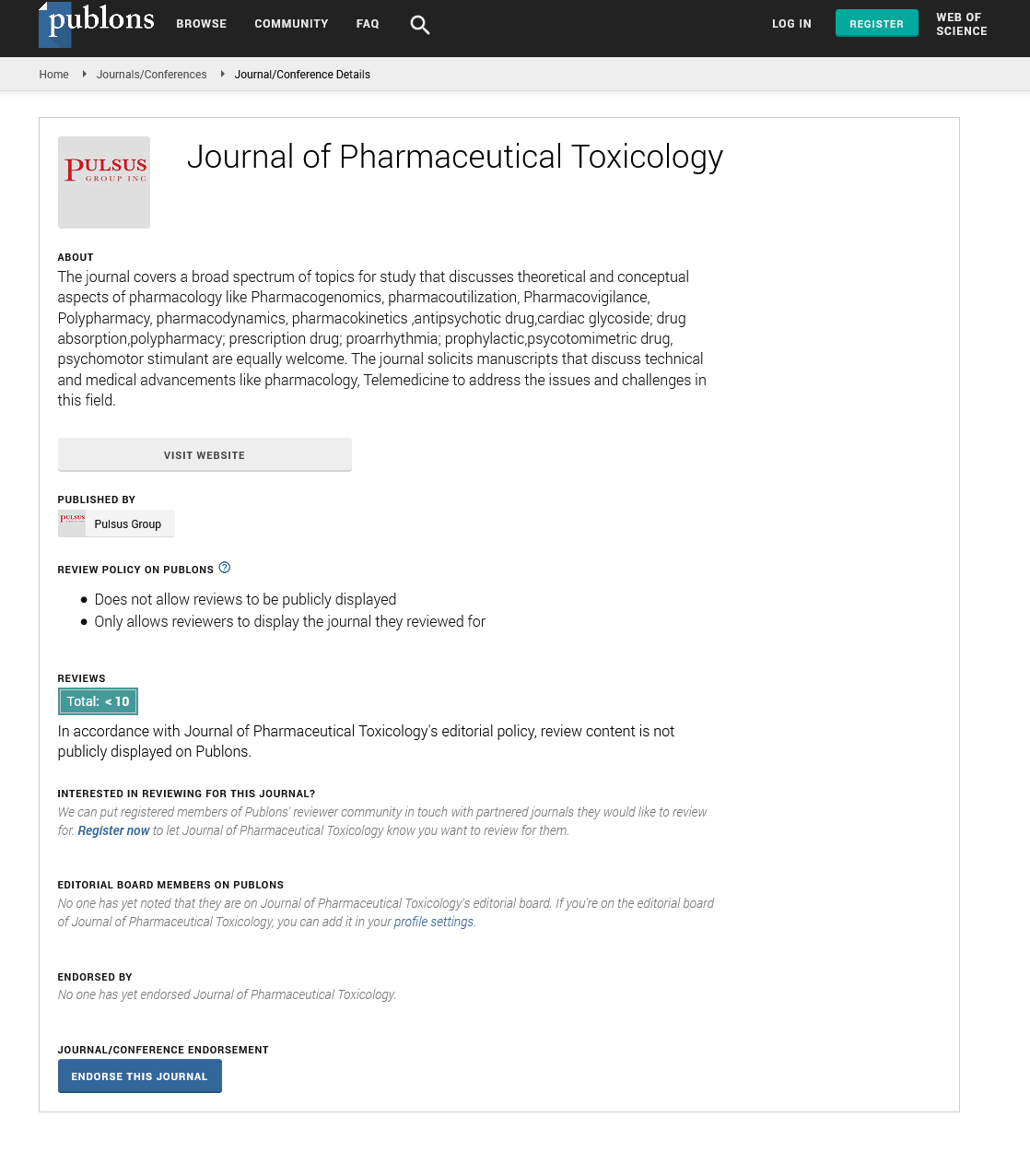Mini Review - Journal of Pharmaceutical Toxicology (2023) Volume 6, Issue 1
Review of Success Factors and Potential Challenges in the Use of Electronic Health Records for Public Health in Asia
Anil Kumar Jha*
DI Skin Health and Referral Center P Ltd, Maharajgunj, Kathmandu 44600, Nepal
DI Skin Health and Referral Center P Ltd, Maharajgunj, Kathmandu 44600, Nepal
E-mail: dranilkjha@hotmail.com
Received: 01-Feb-2023, Manuscript No. jpt-23-88902; Editor assigned: 04-Feb-2023, PreQC No. jpt-23- 88902(PQ); Reviewed: 18-Feb-2023, QC No. jpt-23-88902; Revised: 25- Feb-2023, Manuscript No. jpt-23- 88902(R); Published: 28-Feb-2023, DOI: 10.37532/jpt.2023.6(1).09-12
Abstract
Electronic health records are a useful tool for bettering clinical decision-making, health surveillance, and evaluation. They have been implemented in a variety of contexts, including low- and middle-income nations, but little is known about the development and efficacy of comparable information systems in Asia. This study investigates the use of EHR systems for population health in Asia in order to pinpoint their current function within public health, crucial success criteria, and prospective implementation hurdles. A methodical search procedure was used. MeSH key words and Boolean expressions were used to search five databases. Articles with a component of implementation, utilisation, or assessment for health systems or at least beyond direct patient care were chosen for this review based on hospital provider electronic records. Three interacting elements—the content, the process, and the context—were taken into account by a proposed analytic framework. The review contained 32 articles in all. Benefits appear to be substantial, according to the evidence, but overcoming potential obstacles is essential to success. A thorough planning process is required to put in place a reliable and adaptable system. When used for public health, electronic health records can help identify illness trends, seasonality, worldwide trends, and threats to vulnerable populations. The creation and effectiveness of public health efforts in Asia to identify current health needs and reduce future hazards will be facilitated by addressing implementation issues.
Keywords
drug hypersensitivity • electronic health record • allergy documentation • drug allergy label • health system • asia • clinical trial
Introduction
Electronic health records (EHR) have become increasingly used in medical settings in recent years. EHR systems offer a valuable chance to enhance health surveillance and assess service delivery, which may improve public health management and promotion. Findings indicate that the majority of physicians make use of the information at hand to assess the patient’s general health, guide clinical judgement, and facilitate shared communication within patient care teams. In the United States, by June 2013, 75% of office-based doctors had adopted EHR into their operations. The cost of purchasing and implementing EHR systems is high, but the success of the strategy also hinges on how eagerly the doctors are to incorporate the new technology into their daily practices [1].
Primary clinical care and population health have comparable objectives to enhance the wellbeing of patients and communities, but they rarely form productive alliances to achieve so. Systems must be adaptable to changing healthcare objectives. It might be argued that population health in the current economic climate necessitates the proactive application of techniques and treatments to specific groups of people in order to enhance their health at the lowest possible cost. EHR systems have been used by researchers to collect extensive data on topics like heart disease, smoking, and the provision of preventative treatments [2].
EHR have made it possible to track and combine vaccination programmes, improving the sustainability and design of efficient immunisation schemes. Although it is important to not undervalue the value of EHR in clinical settings, the majority of healthcare providers find it convenient to obtain patient information through EHR. However, the technology needs for health information are always evolving. For instance, it was anticipated that the Patient Protection and Affordable Care Act (ACA) would fundamentally alter the roles of health departments in the United States, necessitating new advancements in health technology in order to track those changes and possibly generating competitive pressures. Data sharing adds a further layer of difficulty by keeping up with policy changes [3].
According to a recent international comparison study on the use of electronic medical records (EMR) for research, there are considerable regional differences in information governance practises, adoption rates, and the time and effort needed to secure consent. The departmental and hospital systems’ current methods for data collection and analysis sometimes lack coordination and effective interconnection, which makes it difficult to analyse and evaluate patient outcomes, especially when they relate to a particular demographic or community. Effective and preventative care management will necessitate a more complex and extensive level of data collection on chosen groups, which is now beyond the capability of the majority of healthcare organizations [4].
However, there are considerable differences between high- and low-income and middleincome countries in the gap between medical demand and supply (HIC; LMIC). Public health professionals face a challenge as the gap between high-income and low- and middle-income countries widens as EHR and EHR systems advance, raising the possibility that the most vulnerable populations will fall further behind in the delivery of efficient healthcare and public health strategies. While industrialised nations like the United States and the United Kingdom have pioneered the adoption of EHR, less is known about the development and efficacy of comparable information systems in Asia. In order to determine their current function within public health, major success criteria, and prospective implementation hurdles, this research investigates the usage of EHR systems at a population health level in Asia [5].
Materials and Methods
The conceptual framework for data visualisation utilising EHR and research analysing the impact of EHR in medical office settings served as the basis for the analytical approach for this review. The context and procedure, together with the content, need to be taken into consideration when evaluating the content for use in public health. The context can also be divided into internal and external categories. The internal context for this review refers to the organisational structure, culture, and resources used by the EHR-using organization [6].
The larger socioeconomic and political environment in which the organisation functions is referred to as the external context. Process is divided into the input process and output process for the purposes of this evaluation. The input process takes into account every aspect of data entry, including cultural considerations and resource availability. The output process takes into account all aspects of data visualisation and its results, Women in Austria and Japan who could read and write German and Japanese and had at least one child between the ages of 3 and 5 participated in this questionnaire survey [7].
Both kindergartens in Styria, Austria, and kindergartens in Hiroshima, Japan participated in the survey. From January 2014 to March 2014, data were independently gathered in each nation using the same cross-culturally validated questionnaires. The study team sent mothers an invitation to participate in the study and an informational letter. The study was supported by the kindergarten, which anonymously collected the questionnaires in boxes. The women weren’t given any money in exchange for taking part. According to research conducted in Japan and Austria, a different response rate of 80% and 40%, respectively, was anticipated. The study was authorised by the institutional review boards of Hiroshima University in Japan and Graz Medical University in Austria [8].
Discussion
Since moms appear to be the primary global gatekeepers of children’s health, the main goal of the current study was to compare the quality of life outcomes and rates of depression among mothers in Japan and Austria. Maternal health has a significant impact on children’s health. Participants in the current study were moms who had at least one kindergarten-aged child between the ages of 3 and 5. According to culturally expected diversity in demographic factors including employment level, education, and living circumstances, women in both countries differed from one another. In our sample, 20% of Austrian women and 70% of Japanese women were unemployed. This is consistent with the OECD report from 2010, which highlights the fact that it is harder in Japan than in other OECD nations to strike a balance between work and home life [9].
In Japan, the percentages for acceptable work hours and flexible work arrangements are relatively low. In Austria, it seems more feasible to live alone with kids. In the Austrian sample, 10% of moms were single, unmarried. This can be explained by the fact that Austrians appear to have a stronger societal tolerance for diversity and feel more empowered to manage their own lives. Both nations have above-average child populations and educational levels. One explanation could be that moms with higher levels of education were more engaged in our study and more likely to be willing to participate in the on-going QOL surveys. The findings of the current investigation piqued the interest of many ladies.
In Japan, the percentages for acceptable work hours and flexible work arrangements are relatively low. In Austria, it seems more feasible to live alone with kids. In the Austrian sample, 10% of moms were single, unmarried. This can be explained by the fact that Austrians appear to have a stronger societal tolerance for diversity and feel more empowered to manage their own lives. Both nations have above-average child populations and educational levels. One explanation could be that moms with higher levels of education were more engaged in our study and more likely to be willing to participate in the on-going QOL surveys. The findings of the current investigation piqued the interest of many ladies. In further crosscultural research, we advise inquiring further about the length of education. Because of the differing living conditions in Japan and Austria, we anticipated disparities in the mothers’ QOL. The outcomes supported this idea. Japanese moms showed lower QOL compared to Austrian mothers across all QOL aspects, including physical, psychological, social, and environmental QOL. The substantial differences, however, were not anticipated given the high standards of life in both nations. On the other hand, according to a prior Central European survey, Austria appears to have high QOL levels even within Europe when compared, for instance, to Slovenia and Italy.
A health resource has been identified as a sense of coherence. In the current investigation, we discovered that the SOC of mothers from Japan and Austria varied. Compared to Japanese moms, Austrian mothers perceive their lives as being more understandable, manageable, and purposeful. This appears to be explicable when compared to the OECD report, which showed that a low proportion of Japanese people believe they are free to live their own lives and that individual human rights are respected. This is further supported by the fact that Japan’s young people have lower potential for autonomy than the OECD average. Further gender variations between moms from Japan and Austria were discovered, pointing to a more conventional role for Japanese mothers. In this regard, Japanese women prioritise their responsibilities at home, and moms feel more responsible for raising their children and think a male should provide the majority of the family’s income. However, women scored the father’s role the highest and similarly in both nations. This indicates that women in both nations think a father should spend a lot of time with his kids during the week rather than only on the weekends. Japan’s reality seems to be different. Compared to 3% in Austria, about 30% of Japanese employees work more than 50 hours every week [10].
Conclusion
Mothers are found in a variety of environmental situations around the world, which warrant more study. Assessing QOL may be a useful strategy for assessing moms’ health outcomes and talking about potential new therapies. The growth, nutritional status, and emotional development of children are all significantly influenced by the mother’s psychosocial and mental health, according to the available research. Therefore, raising the quality of life (QOL) of mothers should be a top concern everywhere in the globe. We would encourage QOL studies among mothers everywhere to identify areas in need of improvement. Creating ways to enhance moms’ quality of life and wellbeing is a further step. It may be possible to improve the quality of life of fathers and children by fostering an environment in which fathers are more actively involved in childrearing and mothers are given more options regarding lifestyles, working conditions, and social settings. This may benefit mothers in other countries in addition to Japan.
Conflict of Interest
None
Acknowledgement
None
References
- García Rodríguez LA, Pérez Gutthann S. Use of the UK general practice research database for pharmacoepidemiology. Br J Clin Pharmacol. 45:419-425 (1998).
- Kimura M, Croll P, Li B et al. Survey on medical records and EHR in Asia-Pacific region. Methods Inf Med. 50:386-391 (2011).
- Eriksson M, Lindström B. Antonovsky's sense of coherence scale and its relation with quality of life: a systematic review. J Epidemiol Community Health. 61:938-944 (2007).
- Danciu I, Cowan JD, Basford M et al. Secondary use of clinical data: the vanderbilt approach. J Biomed Inform. 52:28-35 (2014).
- Kumar S, Chakrabarti R. Amphotericin B both inhibits and enhances T-cell proliferation: inhibitory effect is mediated through H2O2 production via cyclooxygenase pathway by macrophages. J Cell Biochem. 77:361-371 (2000).
- Balasegaram M, Ritmeijer K, Lima MA et al. Liposomal amphotericin B as a treatment for human leishmaniasis. Expert Opin Emerg. 17:493-510 (2012).
- Vanlerberghe V, Diap G, Guerin PJ et al. Drug policy for visceral leishmaniasis: a cost-effectiveness analysis. Trop Med Int Health. 12:274-283 (2007).
- Gosden RG, Feinberg AP. Genetics and epigenetics-nature's pen-and-pencil set. N Engl J Med. 356:731-733 (2007).
- Ivanov M, Kacevska M, Ingelman-Sundberg M et al. Epigenomics and interindividual differences in drug response. Clin Pharm Therap. 92:727-736 (2012).
- Gasparotto D, Miolo G, Torrisi E et al. Improved outcome with multimodal treatment and imagine challenge in advanced GIST. Int J Colorectal Dis. 29:639-640 (2014).
Google Scholar, Crossref, Indexed at
Google Scholar, Crossref, Indexed at
Google Scholar, Crossref, Indexed at
Google Scholar, Crossref, Indexed at
Google Scholar, Crossref, Indexed at
Google Scholar, Crossref, Indexed at
Google Scholar, Crossref, Indexed at
Google Scholar, Crossref, Indexed at


